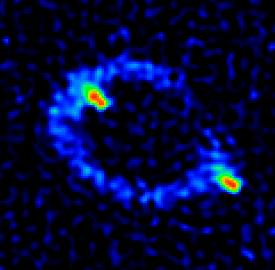Back to VLA Science Highlights



Albert Einstein's General Theory of Relativity, published in 1916, predicted that massive objects, such as stars, could bend light rays passing nearby. This prediction was verified by the observation of such bending of starlight near the Sun in 1919. That same year, an English physicist, Sir Oliver Lodge, suggested that this phenomenon could produce a gravitational lens. In 1936, Einstein himself showed that, if a brightly-emitting object were exactly behind a massive body capable of making a gravitational lens, the result would be an image of a ring around the massive lensing object. However, he dismissed the possibility of ever discovering such a lens, because of the small chance that the precise coincidence required would ever arise.
Optical observers discovered the first gravitational lens in 1979, and the VLA quickly was used to confirm the discovery. The fourth known gravitational lens was discovered with the VLA.
In early 1987, a group of observers led by Jaqueline Hewitt of MIT was using the VLA to make short, two-minute, "snapshot" images of a large number of radio-emitting objects. One of these images, of an object known as MG1131+0456, showed an interesting oval structure, with elongated bright spots at either end. Additional observations of the object later that year showed more detail.
Hewitt and her colleagues considered several possible explanations for what their VLA observations revealed, but all alternatives to an Einstein Ring proved inconsistent. Thus, more than 50 years after Einstein's prediction, the VLA discovered the type of object he had considered unlikely ever to be found. Subsequent studies have shown that this object consists of a distant quasar whose radio emission is being bent, or "lensed" by a galaxy between the quasar and Earth.
The VLA's great angular resolution, or ability to see fine detail, combined with its sensitivity to faint radio emissions, were crucial to this discovery. That the VLA could make such a discovery with only a two-minute observation was the result of technical advances that made the VLA much more capable than its original designers ever contemplated.
Today the VLA remains at the forefront of gravitational-lens research. Observers routinely use the VLA to seek new gravitational lenses. Of the gravitational lenses now known, about half have been discovered with radio telescopes. Studies of gravitational lenses offer important insights into the nature of the Universe. In particular, long-term monitoring of gravitational lenses, showing variations in the strength of the emission of different parts of the lensed image, combined with detailed knowledge of the massive body whose gravitational pull is bending the rays, can allow great improvements in the measurement of large distances. Such measurements can refine significantly the estimates of the size and age of the Universe.
